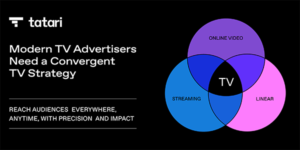According to Deloitte’s fifth edition “State of the Media Democracy” survey, 71% of Americans still rate watching TV on any device among their favorite media activities. In addition, 86% of Americans stated that TV advertising still has the most impact on their buying decisions.
The survey indicates that the Internet, mobile and social media channels are enhancing the overall television viewer experience, driving people to watch first-run programs and live events during their initial broadcast. And, nearly three-quarters of American consumers are multitasking while watching TV. 42% are online, 29% are talking on cellphones or mobile devices, and 26% are sending instant messages or text messages. 61% of U.S. consumers now maintain a social networking site, where constant streams of updates and discussion forums have made delaying awareness of live TV outcomes a near impossibility.
Phil Asmundson, Vice Chairman Deloitte LLP, points out that “… by embracing the Internet as a platform that encourages audiences to participate in discussions about their favorite programs, television is maintaining its hold on the American public… ”
According to this year’s survey, 33% of American households now own a smartphone, up from 11% only three years ago, and 40% of U.S. consumers that do not own a smartphone are likely to purchase one in the near future. This marked rise in smartphone penetration in the U.S. market is rapidly changing consumer behavior with 56% of smartphone and laptop owners stating that they used their smartphones as a replacement for their laptop while away from home, jumping significantly from 41% in only three months.
Mobile Internet use is quickly decoupling the Internet experience from the desktop for almost half of the population. This will facilitate new consumer behaviors, likely including increased mobile search, purchasing and social networking:
- 48% of U.S. Consumers have a voice and data plan for their mobile/smartphones; 26% state this plan is their most valued media & entertainment service
- 47% of U.S. consumers state their “smartphone” is one of their three most valuable media & entertainment products; ranking it as #4 among owners
- Consistently over the last three years, roughly a third of U.S. consumers use their mobile phone as an entertainment device
According to the survey, since 2007 a consistent 70% of Americans state that they enjoy reading printed magazines even though they know that they could find most of the same information online, and 55% have continued to subscribe to printed magazines. Since 2007, a consistent 80% of Americans who have read their favorite magazine state that reading the printed copy is their favorite method.
James McDonnell, principal, Deloitte Consulting LLP, says “… enthusiasm for printed magazines is consistent across all age groups, a unique result in consumer attitudes across all the media categories, we surveyed…
| Advertising With Most Impact On Buying Decision (% of Respondents) | ||||||
| All | Trailing Millennials | Leading Millennials | Xers | Boomers | Matures | |
| TV | 83% | 80 | 82 | 86 | 82 | 80 |
| Magazines | 50 | 44 | 45 | 45 | 53 | 67 |
| Online | 47 | 55 | 69 | 46 | 41 | 32 |
| Newspapers | 44 | 20 | 17 | 37 | 59 | 79 |
| Radio | 32 | 26 | 22 | 37 | 34 | 27 |
| Billboards/outdoor advertising | 13 | 11 | 12 | 14 | 13 | 8 |
| In-theater advertising | 11 | 27 | 19 | 10 | 6 | 3 |
| Source: Deloitte Research, March 2011 (Trailing Millennials: Age 14-20, Leading Millennials: 21-26, Generation X: 27-43, Baby Boomers: 44-62, Matures: 63-75) | ||||||
| Advertising attitudes: Percent of Consumers Strongly/Somewhat Agreeing | |||||||
| All | Millennials | Xers | Boomers | Matures | Males | Females | |
| I tend to pay greater attention to print advertising in magazines than any type of advertising on the Internet | 60% | 64 | 58 | 58 | 59 | 56 | 63 |
| I tend to pay greater attention to print advertising in newspapers than any type of advertising on the Internet | 54 | 49 | 53 | 55 | 67 | 54 | 54 |
| I would pay an annual subscription fee for my favorite TV shows to watch them without advertisements | 28 | 37 | 29 | 23 | 21 | 30 | 26 |
| I would rather pay for online content (news, information, sports, games, social interaction sites, movies, music, and television) in exchange for not being exposed to advertisements | 26 | 32 | 26 | 22 | 24 | 29 | 24 |
| I would be willing to provide more personal information online if that meant I could receive advertising more targeted to my needs and interests | 24 | 32 | 28 | 17 | 18 | 27 | 22 |
| I am comfortable with having my web browsing activity tracked so that I could receive advertising more targeted to my needs and interests | 21 | 24 | 24 | 16 | 16 | 24 | 18 |
| Source: Deloitte Research, March 2011 | |||||||
Access to mobile devices and broadband have made the average consumer more connected to the Internet than ever and new online storage models have become real options for the mass market. According to the survey, most Americans own a device that allows them to easily connect to the Web – 85% of consumers own a desktop computer, 68% own a laptop/netbook computer and 41% access the Internet on their mobile phone.
Additional Key Findings:
TV continues to reign as the most influential advertising platform, and online ads are considered influential by less than half of Americans. Yet, with the rise of social media, says the report, we are beginning to see online engagement with consumers happening in a much different, more social way:
- The ability of ads on web sites to move traffic to other sites has dropped from 72% to 59% over the past three surveys
- 57% of U.S. consumers currently maintain a social networking site
- 26% of U.S. consumers are socializing online everyday/almost everyday (via social networking sites, chat rooms or message boards)
- 55% of U.S. consumers believe strongly/somewhat that online consumer reviews and ratings influence their buying decisions more than any type of online advertising
- 51% of U.S. consumers have purchased a product based on an online recommendation
- 65% of U.S. consumers frequently/occasionally visit web sites as a result of someone’s online recommendation
- 24% of U.S. consumers would find it extremely/very desirable to have an online service that recommends a product based on other consumers’ preferences
- 65% of U.S. consumers frequently/occasionally visit web sites as a result of someone’s online recommendation
- 55% of Americans believe strongly/somewhat that online consumer reviews and ratings influence their buying decisions more than any type of online advertising
News Features vs. Advertising
According to a recent Roper Survey:
Six times more people watch/read/listen to news features than ads.
News Features are third party endorsements, ads are not.
News Features can communicate much more information than an ad.
The Wharton School of Business, University of Pennsylvania conducted a major research study on print versus video. Their conclusions showed that a well-produced video increases information retention by 50% and speeds-up buying decisions by 72% over a print brochure.


